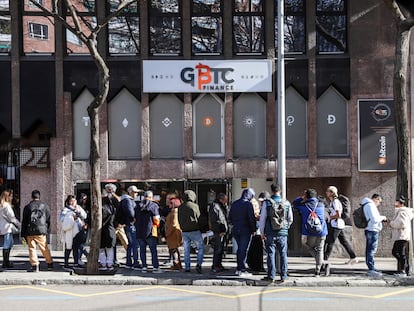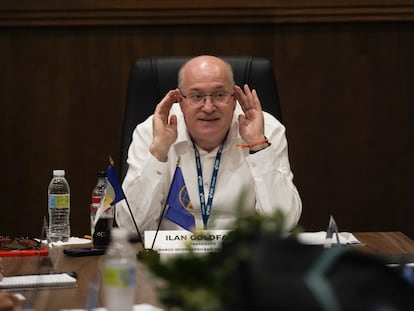US regional banks, the weakest link a year after the fall of Silicon Valley Bank
Concerns have shifted to exposure to commercial real estate credit. The IMF estimates that vulnerable lenders have $5.5 trillion in assets, 23% of the total


When he was Secretary of the Treasury, Steven Mnuchin and his wife attended the issuance of the first banknotes that bore his signature, triggering many jokes and memes about them looking like movie villains. This week, Mnuchin has become the hero, at least temporarily, after he came to the rescue of New York Community Bancorp (NYCB), which is fighting for its survival following a flood of bad news. NYCB illustrates the extent to which U.S. regional banks remain under pressure a year after the collapse of Silicon Valley Bank (SVB). It is also the best example of how concerns have shifted from interest rate risk and liquidity to commercial real estate credit exposure.
A report released this past week by the International Monetary Fund (IMF) notes that the group of weak U.S. banks represents an estimated total of $5.5 trillion in assets, almost 23% of total banking assets. “Underlying concerns persist, with fears that the failure of one institution could precipitate a broader loss of confidence in the sector,” says the report.
The latent losses due to the rise in rates (which have devalued the banks' bond portfolio) are combined with the credit risk of some entities, particularly their exposure to commercial real estate credit (CRE). Small and regional banks are highly exposed, with about two-thirds of the $3 trillion of risk in that sector of the U.S. banking system, according to the IMF.
“The high concentration of CRE exposures represents a serious risk to small and large banks amid economic uncertainty and higher interest rates, potentially declining property values, and asset quality deterioration,” the report states.
For now, the NYCB crisis appears to be contained, not only because the entity has found a lifeline, but because the contagion effect has been smaller. However, given the interconnectedness of the financial system, even the bankruptcy of a non-systemic entity can threaten overall financial stability. That much was demonstrated by the fall of SVB, the second-largest bank failure in the history of the United States, which was followed days later by Signature Bank (the third) and a few weeks after that by First Republic Bank. All of them were bailed out by the Federal Deposit Insurance Corporation (FDIC), which is now sending the bill to the banks.
The banking crisis of a year ago can be explained as a butterfly effect of the pandemic. With the Covid crisis, the federal government gave out generous aid and deposits skyrocketed. Some banks invested these resources in long-term bonds. The liquidity fueled inflation and that led the Federal Reserve to raise rates. With the rate increases, capital losses appeared in bond portfolios, while deposits were reduced (particularly in venture capital and new technology companies, both of which were SVB clients). The clamp squeezed on both sides: liabilities (deposits) and assets (bonds).
A disastrous recommendation
The fall of Silicon Valley Bank, however, was also due to other factors. The SVB ship may have had a leak, but perhaps could have reached port in time for repairs if not for a storm of factors. Everything that could go wrong went wrong. The former CEO of SVB, Gregory Becker, explained in the Senate that his bank, like many others, had losses in its debt portfolio, but that he allowed himself to be advised by Goldman Sachs to sell it and increase capital in what ended up being a disastrous recommendation.
“On the advice of Goldman Sachs, we decided to sell our available-for-sale portfolio in order to realize those losses and explain to the market why we were raising capital, given that SVB’s finances were otherwise healthy. SVB had sufficient liquidity and was adequately capitalized on March 8 [the day it launched that operation on the advice of Goldman Sachs], as its Federal Reserve supervisory teams had previously acknowledged,” Becker said.
On March 8, the day the operation was announced, Silvergate Bank, focused almost 100% on cryptocurrencies, announced its voluntary liquidation. Although SVB only had about 3% of its customer deposits in cryptocurrency, it had been compared to Silvergate in the Financial Times two weeks earlier. On March 9, SVB collapsed on the stock market, unleashing panic. “The fall of Silvergate and the link to SVB caused rumors and misconceptions to spread rapidly across the internet, leading to the start of what would become an unprecedented deposit drain. [...] $42 billion in SVB deposits were withdrawn in 10 hours, or approximately $1 million every second,” Becker explained.
After almost 40 years of existence, Silicon Valley Bank was destroyed in about 40 hours. While trying to obtain liquidity, on the morning of March 10, the FDIC intervened. That day, another $100 billion in withdrawals was requested, bringing the sum to $142 billion, 80% of total deposits, in just two days. The previous largest bank run in U.S. history, by Washington Mutual in 2008, had been $19 billion in 16 days. Deposit insurance was created to prevent banking panics, but in the case of SVB, the vast majority were unguaranteed deposits from investment, venture capital and technology firms, which led the stampede.
“This experience has changed everyone’s perception of the possible speed of bank runs. What occurred in two or three weeks or, in some cases, many months in previous episodes may, in the modern era, now occur in hours,” said Federal Reserve Vice Chair for Supervision Michael Barr last December. “The March 2023 turmoil potentially showed [how] the growing influence of technological advances, such as mobile banking and the rapid spread of information through electronic communications, could have contributed to the speed of the deposit run,” according to the IMF report.
Supervisory failures
SVB was “a textbook case of mismanagement of interest rate and liquidity risk‚” in Barr’s words. Successive autopsies revealed that it was also a textbook case of poor supervision. “The SVB managers fell asleep at the wheel, but so did the regulators,” said Gary Cohn, vice president of IBM who was then president of Goldman Sachs, at an event organized by the Brookings Institution this week in Washington. Warning signs arose again and again, but they were not stopped in time. “I was amazed at what Silicon Valley Bank and First Republic Bank were able to do,” said William Demchak, the head of PNC Financial, the eighth-largest bank in the United States, at the same event. “Ironically, the overdue actions it finally took to strengthen its balance sheet sparked the uninsured depositor run that led to the bank’s failure,” Barr explained on the Senate floor. Citibank analysts called the bank’s downfall “self-inflicted.”
Following SVB, Signature Bank (SB) and First Republic Bank collapsed. All three had in common a high concentration of uninsured deposits, significant unrealized losses and exposure to residential real estate credit before bankruptcy. After the fall of SVB and SB, the Federal Reserve tried to calm the waters in two ways: by guaranteeing the uninsured deposits of these entities (for this it had to allege systemic risk) and opening a special liquidity window in which banks have asked for as much as $165 billion with debt securities as collateral. The Fed decided to close it after verifying that banks were using it for arbitrage and making profits.
Deposit runs are something of a self-fulfilling prophecy. No bank has the liquidity to return the money if all clients ask for it at the same time. That is why bank runs are so dangerous. Following last year’s experiences, the supervisor is now monitoring liquidity risk more closely. However, when it comes to regulation, some voices within the Federal Reserve warn of the risk of overreacting. Michelle Bowman, a Fed advisor, on Friday said she has “significant concerns” about possible regulatory reforms involving liquidity requirements. All banks must manage their liquidity, but must have flexibility based on a number of factors, such as risk, business model, size, complexity, funding needs, vulnerability to deposit withdrawals and other considerations, she said. “Liquidity requirements, if not appropriately designed and calibrated, could trap resources that would otherwise be put to better use, like lending to bank customers,” said Bowman.
Another consequence of the crisis was an increase in banking concentration, in two ways. On the one hand, savers sought refuge in the largest entities. On the other hand, large lenders purchased the assets and liabilities of the fallen banks. J.P. Morgan, which took over First Republic Bank, was the biggest beneficiary in both ways.
The earthquake had aftershocks in Europe with the fall of Credit Suisse, but it did not trigger a full-blown financial crisis, as the authorities acted to prevent transmission. That is the positive reading. The negative is that “vulnerabilities persist in the U.S. banking sector,” as the IMF maintains.
“Last year’s bank stress underscores the importance of not becoming complacent,” Loretta Mester, president of the Federal Reserve Bank of Cleveland, said last week at a keynote address at Columbia University in New York. “We need to look holistically at the regulations, our methods of supervision, and our lender of last resort function to address the vulnerabilities that were revealed,” she added.
NYCB, now on the ropes, was the lender that took over most of the liabilities of Signature Bank, one of the banks that collapsed a year ago. And the pressure is also intensifying against a small, struggling entity with an unfortunate name: Republic First Bancorp, which only serves as a reminder of the crisis of a year ago.
Sign up for our weekly newsletter to get more English-language news coverage from EL PAÍS USA Edition
Tu suscripción se está usando en otro dispositivo
¿Quieres añadir otro usuario a tu suscripción?
Si continúas leyendo en este dispositivo, no se podrá leer en el otro.
FlechaTu suscripción se está usando en otro dispositivo y solo puedes acceder a EL PAÍS desde un dispositivo a la vez.
Si quieres compartir tu cuenta, cambia tu suscripción a la modalidad Premium, así podrás añadir otro usuario. Cada uno accederá con su propia cuenta de email, lo que os permitirá personalizar vuestra experiencia en EL PAÍS.
¿Tienes una suscripción de empresa? Accede aquí para contratar más cuentas.
En el caso de no saber quién está usando tu cuenta, te recomendamos cambiar tu contraseña aquí.
Si decides continuar compartiendo tu cuenta, este mensaje se mostrará en tu dispositivo y en el de la otra persona que está usando tu cuenta de forma indefinida, afectando a tu experiencia de lectura. Puedes consultar aquí los términos y condiciones de la suscripción digital.
More information
Archived In
Últimas noticias
Welcome to the post-religion era: The idea of Christianity as the absolute truth has become obsolete
‘I thought you would like it’: The risky sexual practice popularized by TV shows and TikTok
The digitalization of tourism: ‘They promise experiences and gave us the worst possible one’
Mexican peso defies uncertainty with forecasts of a new period of stability in 2026
Most viewed
- Sinaloa Cartel war is taking its toll on Los Chapitos
- Oona Chaplin: ‘I told James Cameron that I was living in a treehouse and starting a permaculture project with a friend’
- Reinhard Genzel, Nobel laureate in physics: ‘One-minute videos will never give you the truth’
- Why the price of coffee has skyrocketed: from Brazilian plantations to specialty coffee houses
- Silver prices are going crazy: This is what’s fueling the rally










































